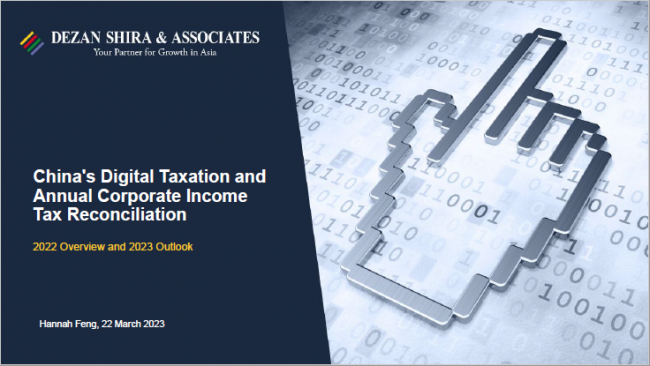We examine the challenges and common errors related to outbound payments from China, with a specific emphasis on non-trade foreign exchange transactions. Such outbound payments are subject to thorough examination by both China's tax and foreign exchange authorities.
Outbound payments from China businesses to overseas parties have always been under close scrutiny from the tax and foreign exchange authorities. Especially after the three years pandemic, individual governments are intensifying their own tax and regulatory frameworks, to protect their tax revenue amid financial constraints and to manage domestic jurisdiction compliance in a dynamic global business environment. China is no exception. This requires companies to reassess their strategies concerning dividend repatriation or payback.
In this article, we introduce the challenges and common mistakes associated with outbound payments, focusing on non-trade foreign exchange payments (hereinafter, referred to as non-trade outbound payments).
Typical scenarios for outbound payments
During the establishment and at the early stage of a company's operations in China, it’s very common that the China subsidiaries will have a lot of interactions with the headquarter in addition to financial support, which could involve the use of brand, intellectual property, and other resources provided by the overseas parent company. In these scenarios, the Chinese entity should pay royalties, brand licensing fees, technology services fees, and service fees for management to the headquarters. In addition, under the centralized administrative management set up by the group company, the China entity should also pay for administrative services it received at the group level.Later when the local company stabilizes and starts generating positive cash flow and profits, it’s also common that the headquarter may arrange the local entity to share the cost of the group company in the form of franchise usage fees, consulting service fees, or repayment of advances prepaid by the headquarter forservices, databases, or software purchased for the group . These payments are made by the local company to the parent company or other enterprises within the company group.
In these scenarios, payments may include:
- Service fees
- Royalties
- Dividends
- Expenses prepaid by related parties on behalf of the domestic party (e.g., foreign employees are paid by the headquarters on behalf of the China entity in the employee’s home country)
Challenges and considerations on making outbound payments
Outbound payments are under the close scrutiny of the both the tax authorities and the foreign exchange authorities.From foreign exchange management perspective, outbound payments are broadly categorized into current account items and capital account items:
- Capital account items refer to transactions causing changes in external assets and liabilities, including direct investments and loans.
- Current account items refer to transactions involving goods, services, income, and frequent transfers in the balance of payments.
From the tax perspective, transfer pricing adjustments have been more common than before. Both the State Tax Administration and the State Administration of Foreign Exchange have released guiding documents on the processing of TP adjustments.
To be more specific, resident companies may face following challenges regarding outbound payments:
Paying service fees or royalties and sharing group-allocated expenses when the company is operating at a loss
When the company is operating at a loss, it will face more challenges to make outbound payments in the form of service fees, royalties, or sharing group-allocated expenses.In this context, there are several critical factors that require the taxpayer’s careful consideration:
- Reasonableness and Commercial Purpose: First and foremost, it's essential to assess the reasonableness of the outbound payments of service fees and royalties. Is there a clear and justifiable commercial purpose behind these payments, especially when the company is already operating at a loss? These transactions must undergo rigorous evaluation, including passing the six transfer pricing tests regarding intercompany service fee payments. Among others, it's crucial that these transactions adhere to the arm's length principle, under which taxpayers should be able to demonstrate that they transact with related parties in a similar manner and under comparable conditions, as they would with third parties. Especially with regard to allocated fees, it is important to determine whether service fees are calculated based on a globally consistent service analysis and whether this information is disclosed in the group's master file. Additionally, if the service fees do not have external comparable uncontrolled transactions, the company should consider whether the allocated service fees are reasonably distributed among the relevant beneficiaries based on their scope of benefit.
- Goods Import-Related: Regarding agreed-upon royalties, particular attention is needed to determine whether they are related to the import of goods. Import-related royalties implies tax liabilities related to customs duties. Consequently, it’s important to plan in advance for tax efficiency.
- DEMPE+P Test: Apart from the reasonableness and independence transaction principles mentioned earlier, companies need to consider whether these royalties can pass the DEMPE+P test. DEMPE, representing for development, enhancement, maintenance, protection, and exploitation of intangibles, is a concept first introduced by the Organization for Economic Co-operation and Development (OECD) in 2015 for determining the arm’s length return of intangibles in transfer pricing cases. Under this concept, members of the multinational company (MNC) group are to be compensated based on the value they create through functions performed, assets used, and risks assumed in the DEMPE of intangibles. The extra P, representing for promotion, is an extra special factor considered in China, which means the tax authority in China also recognize the value created by marketing activities of China entities. Passing the DEMPE+P Test involves assessing whether the royalty rate is reasonable and whether it fluctuates in correspondence with the changing industry environment or other factors.
- Cumulative Deferred Payments: It's essential to determine whether the payments are cumulatively deferred and, if these are delayed payments, investigate the reasons behind these delays and whether a more recent payment plan aligns better with the current situation. Ensure that the corresponding expenses are calculated based on the contract, properly invoiced, and accurately recorded in the company's book of operating income and expenses. If the company is operating in a loss-making position, distinguish between short-term fluctuations and long-term financial burdens.
- Impact on Group Tax Burden: Lastly, consider how these payments and settlements impact the overall tax burden of the group. Ensure that there are no special tax arrangements that may raise concerns or legal complications.
Challenges regarding repayment of related party prepaid expense on behalf of the domestic entity
Common example related party prepaid expense on behalf of the domestic entity include salaries paid by the headquarter or other related parties on behalf of the China entity to the foreign employee at the foreign employee’s home country, commercial insurance premiums paid for the group company, overseas travel expenses, training expenses, and logistics expenses paid by the headquarter or other related parties.Effectively managing these related party prepaid expenses and transactions on behalf of the domestic entity is a complex task, requiring attention to various key factors:
- Proper Recording of Liabilities: In cases of prepayment, it is essential to ensure that liabilities to the payee have been correctly recorded on the balance sheet and that the services corresponding to the prepayment have been recognized properly. This means the prepaid expenses should align with the services received or costs incurred. This is a critical aspect of accurate financial reporting and compliance.
- Preparation of Supporting Materials: When preparing supporting materials for the outbound payments, taxpayers are suggested to: 1)explicitly state the reasons for the prepayment in the agreement; 2) clearly specify that the overseas company retains the obligation to provide payment vouchers and proof; 3)emphasize the dominant role of the domestic company in the matter, rather than the overseas company; 4) provide additional supporting materials that further substantiate the nature of the transactions and the justification for prepayment.
- Related Party Relationships: When arranging payments for expenses prepaid on behalf of related parties, remember it can affect the tax implications and compliance requirements.
- Internal Agreements: There should be internal agreements specifying the nature and terms of the prepaid expenses. These agreements serve as a foundation for compliance and accurate record-keeping. Also, according to foreign exchange business guidelines, it should generally not exceed 12 months from the signing of such agreements to the payments.
- Completeness of Payment Records: To ensure transparency and compliance, it's essential to maintain complete records of expense assumption and payment. The records should be thorough and well-organized. This documentation helps demonstrate that the transactions represent prepaid expenses, not service fees, thus avoiding tax liabilities.
Challenges regarding transfer pricing adjustments
Transfer Pricing adjustments involve adjusting the pricing of transactions between related entities to ensure compliance with tax regulations and accurately reflect market conditions. With the global transfer pricing landscape has grown more complex in recent years, it can be challenging for MNEs to navigate and stay compliant.
To deal with transfer pricing adjustments, companies should consider the following strategies:
- Regularly review and update the company’s transfer pricing policies to align with changing regulations and market dynamics.
- Engage transfer pricing experts to conduct thorough transfer pricing risk assessments and recommend appropriate adjustments.
- Maintain detailed documentation and records of transfer pricing adjustments to demonstrate compliance and reasoning.
Common mistakes in outbound payments
In outbound payments, some common mistakes can be observed during the process, triggering compliance risks for both the resident and non-resident enterprises. We provide more details below.Absence of essential contract elements and incomplete content clauses
The absence of contract elements and incomplete contents will affect the tax authorities' recognition of the authenticity and rationality of the contract, thus posing a significant tax risk.To be more specific, such mistakes could be in the following forms:
- These contracts may only contain names of the parties, contact information, and prices, without basic terms such as the object of the contract, the time limit for performance and the place, and there is no supplementary agreement .
- The contract lacks signatures and seals of both parties, and the date of signing is not filled in.
- The Chinese and English versions of the contract are inconsistent, e.g., the Chinese contract is an engineering service agreement, while the English contract is the management service agreement.
- There are no specific provisions on the charging standard and settlement basis.
Intentionally splitting large contracts into multiple transactions
Some companies deliberately split large contracts into smaller payments to evade tax filing and supervision.For example, a domestic company signed a US$200,000 lease contract with a foreign entity and divided the payments into five transactions, so that each payment was below the US$50,000 threshold for outbound payment tax filing. This practice aims to avoid regulatory scrutiny and save taxes.
However, tax authorities closely monitor such activities and may impose penalties and sanctions to the incompliant taxpayers.
Failing to withhold the tax
By law, the withholding agent shall withhold the tax on the date of actual payment and declare and pay the withholding tax to the local competent tax authority within seven days from the date of occurrence of the withholding obligation. If the withholding agent fails to withhold the tax, the tax authority can order them to make up the withholding tax and may hold them accountable for any associated consequences.Change the form of the outbound payment to avoid withholding tax
In practice, some businesses may deliberately change the outbound payment method to reduce tax burden. This is risky.For example, a foreign invested enterprises (FIEs) has made profit distribution resolution but never actually remit the fund abroad and withhold taxes. Instead, it transferred the money to a domestic third party, who is the creditor of the overseas shareholder. In this case, the tax authority, however, may deem that the foreign party has received the dividend and thus is subject to corporate income tax retrospectively.
Foreign shareholders avoiding withholding tax through capital reduction and withdrawal
Another example can be seen where an overseas shareholder withdraws or reduces its investment in a domestic enterprise, but only recovers the original investment cost, without reporting any income from the reduction or withdrawal.Under the current tax laws and regulations, when non-resident enterprises withdraw or reduce their investment, tax authorities require that the equity value corresponding to the withdrawal or reduction should be measured at fair value, and the recovered amount should be recognized in accordance with the prescribed order as investment cost, dividends, and income from equity transfer.
Where the fair value of the equity corresponding to the divestment far exceeds the initial investment cost, and the dividend and equity transfer income are not recognized, which reduces the withholding tax of China, the foreign invested resident company and the overseas non-resident company might be subject to legal repercussions and financial penalties.
Improper income reporting
Failing to report income properly as agreed in the contract can lead to tax compliance risks.For instance, if a company pays royalties to an overseas company and it is agreed in the contract that the tax is to be borne by the domestic company, and the royalties fee stated in the contract is net profit for the overseas company. In this case, the income amount to calculate and declare withholding tax should be the pre-tax amount restored, rather than the royalties fee stated in the contract.
Lack of genuine commercial activity
Tax authorities remind that payments made to foreign companies as business costs or expenses before tax deduction, should be based on the premise of genuine business activities. Payments lacking a genuine commercial basis may be deemed falsely listed costs or expenses, leading to potential tax adjustments.For example, a company signed multiple service contracts with affiliated enterprises, some of which may be fictitious, resulting in duplicate payments. Another example is that a company signed new technical assistance contracts with overseas parent companies during the profit increasing year and paid service fees, but it cannot provide specific details or relevant proof of technical services.
Such activities can be flagged by tax authorities.
Key takeaway
Outbound payments to overseas companies have always been under close scrutiny of relevant authorities.By understanding the typical payment scenarios, common challenges, and associated risks, companies can make informed strategies, enhance compliance, and maintain a transparent and accountable approach in managing outbound payments.























